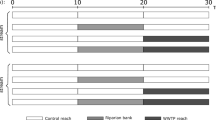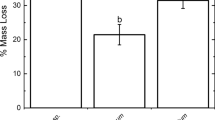Abstract
The effect of the fungicide pyrimethanil (0.7 mg L−1) on biofilm development and alder leaf litter decomposition in aquatic ecosystems was assessed in outdoor lentic mesocosms immediately and 274 days after pyrimethanil application. Pyrimethanil decreased ergosterol concentrations (an indicator of fungal biomass) and the abundance and richness of the macroinvertebrate community associated with decomposing leaves. However, because neither fungi nor macroinvertebrates were main factors contributing to decomposition in this particular system, organic matter processing rates were not affected. After 274 days, pyrimethanil concentration in the water column was ≤0.004 mg L−1 but richness, biomass and composition of the invertebrate community associated with decomposing leaf-litter still showed the effect. The comparison of ergosterol (a molecule existing on both algae and fungal cell membranes), with chlorophyll (an indicator of algal biomass) associated with biofilm suggests that pyrimethanil may decrease fungal biomass and alter the relative abundance of algae and fungi on biofilm developing in control- and treated-mesocosms.






Similar content being viewed by others
References
Abelho M (2001) From litterfall to breakdown in streams: a review. Sci World 1:656–680
Artigas J, Majerholc J, Foulquier A, Margoum C, Volat B, Neyra M, Pesce S (2012) Effects of the fungicide tebuconazole on microbial capacities for litter breakdown in streams. Aquat Toxicol 122–123:197–205
Baldy V, Chauvet E, Charcosset J-Y, Gessner MO (2002) Microbial dynamics associated with leaves decomposing in the mainstream and floodplain pond of a large river. Aquat Microb Ecol 28:25–36
Boulton AJ, Boon PI (1991) A review of methodology used to measure leaf litter decomposition in lotic environments: time to turn over an old leaf? Aust J Mar Freshw Res 42:1–43
Brumfield KM, Moroney JV, Moore TS, Simms TA, Donze D (2010) Functional Characterization of the Chlamydomonas reinhardtii ERG3 Ortholog, a Gene Involved in the Biosynthesis of Ergosterol. PLoS One 5(1):e8659. doi:10.1371/journal.pone.0008659
Buesing N, Gessner MO (2006) Benthic bacterial and fungal productivity and carbon turnover in a freshwater marsh. Appl Environ Microbiol 72(1):596–605
Burns A, Ryder DS (2001) Potential for biofilms as biological indicators in Australian riverine systems. Ecol Manag Restor 2(1):53–63
Cole JK, Hutchison JR, Renslow RS, Kim Y-M, Chrisler WB, Engelmann HE, Dohnalkova AC, Hu D, Metz TO, Fredrickson JK, Lindemann SR (2014) Phototrophic biofilm assembly in microbial-mat-derived unicyanobacterial consortia: model systems for the study of autotroph-heterotroph interactions. Front Microbiol 5(109):1–18
Cunha-Santino MB, Sciessere L, Bianchino I Jr (2008) As atividades das enzimas na decomposição da matéria orgânica particulada em ambientes aquáticos continentais. Oecol Bras 12(1):30–41
Di Pippo F, Ellwood NTW, Guzzond A, Bohne A, Congestri R (2014) Biomass accumulation and species succession in cultured phototrophic biofilms. Eur J Phycol 49(3):384–394
EFSA (2006) Conclusion regarding the peer review of the pesticide risk assessment of the active substance pyrimethanil. EFSA Sci Rep 61:1–70
Felip M, Catalan J (2000) The relationship between phytoplankton biovolume and chlorophyll in a deep oligotrophic lake: decoupling in their spatial and temporal maxima. J Plankton Res 22(1):91–105
Fernández D, Voss K, Bundschuh M, Zubrod JP, Schäfer RB (2015) Effects of fungicides on decomposer communities and litter decomposition in vineyard streams. Sci Total Environ 533:40–48
Frankart C, Eullaffroy P, Vernet G (2002) Photosynthetic responses of Lemna minor exposed to xenobiotics, copper, and their combinations. Ecotoxicol Environ Saf 53:439–445
Gessner MO (2005) Ergosterol as a measure of fungal biomass. In: Graça MAS, Bärlocher F, Gessner MO (eds) Methods to study litter decomposition: a practical guide. Springer, Berlin, pp 171–176
Gessner MO, Chauvet E (1997) Growth and production of aquatic hyphomycetes in decomposing leaf litter. Limnol Oceanogr 42:496–595
Gessner MO, Chauvet E (2002) A case for using litter breakdown to assess functional stream integrity. Ecol Appl 12(2):498–510
Gregoire C, Payraudeau S, Domange N (2010) Use and fate of 17 pesticides applied on a vineyard catchment. Int J Environ Anal Chem 90(3–6):406–420
Gustafsson K, Blidberg E, Elfgren IK, Hellström A, Kylin H, Gorokhova E (2010) Direct and indirect effects of the fungicide azoxystrobin in outdoor brackish water microcosms. Ecotoxicology 19(2):431–444
Hieber M, Gessner MO (2002) Contribution of stream detrivores, fungi, and bacteria to leaf breakdown based on biomass estimates. Ecology 83(4):1026–1038
Kirschner AKT, Velimirov B (1999) Benthic bacterial secondary production measured via simultaneous 3H-thymidine and 14C-leucine incorporation, and its implication for the carbon cycle of a shallow macrophyte-dominated backwater system. Limnol Oceanogr 44:1871–1881
Knight SC, Anthony VM, Brady AM, Greenland AJ, Heaney SP, Murray DC, Powell KA, Schulz MA, Spinks CA, Worthington PA, Youle D (1997) Rationale and perspectives on the development of fungicides. Annu Rev Phytopathol 35:349–372
Köhler HR, Triebskorn R (2013) Wildlife ecotoxicology of pesticides: can we track effects to the population level and beyond? Science 341:759–765
Komárek M, Čadková E, Chrastný V, Bordas F, Bollinger J-C (2010) Contamination of vineyard soils with fungicides: a review of environmental and toxicological aspects. Environ Int 36:138–151
Kookana RS, Baskaran S, Naidu R (1998) Pesticide fate and behaviour in Australian soils in relation to contamination and management of soil and water: a review. Aust J Soil Res 36(5):715–764
McCree KJ (1981) Photosynthetically active radiation. In: Lange OL, Nobel PS, Osmond CB, Ziegler H (eds) Encyclopedia of plant physiology. Springer, Berlin, pp 41–55
Medeiros AO, Pascoal C, Graça MAS (2009) Diversity and activity of aquatic fungi under low oxygen conditions. Freshw Biol 54:142–149
Müller R, Seeland A, Jagodzinski LS, Diogo JB, Nowak C, Oehlmann J (2012) Simulated climate change conditions unveil the toxic potential of the fungicide pyrimethanil on the midge Chironomus riparius: a multigenerational experiment. Ecol Evol 2:196–210
Oruc HH (2010) Fungicides and their effects on animals. In: Carisse O (ed) Fungicides. InTech, pp 349–362. http://www.intechopen.com/books/fungicides/
Patterson GW (1967) Sterols of Chlorella. II. The occurrence of an unusual sterol mixture in Chlorella vulgaris. Plant Physiol 42:1457–1459
Patterson GW (1969) Sterols of Chlorella—III. Species containing ergosterol. Comp Biochem Physiol 31(3):391–394
Paul RW Jr, Kuhn DL, Plafkin JL, Cairns J Jr, Croxdale JG (1977) Evaluation of natural and artificial substrate colonization by scanning electron microscopy. Trans Am Microsc Soc 96(4):506–519
Petersen RC, Cummins KW (1974) Leaf processing in a woodland stream. Freshw Biol 4:343–368
Piepho M, Martin-Creuzburg D, Wacker A (2010) Simultaneous effects of light intensity and phosphorus supply on the sterol content of phytoplankton. PLoS One 5(12):e15828. doi:10.1371/journal.pone.0015828
Premdas PD, Kendrick B (1991a) Colonization of autumn-shed leaves by four aero-aquatic fungi. Mycologia 83(3):317–321
Premdas PD, Kendrick B (1991b) Seasonal sporulation of some aero-aquatic fungi. Arch Hydrobiol 122(4):479–482
Ramaraj R, Tsai DD-W, Chen PH (2013) Chlorophyll is not accurate measurement for algal biomass. Chiang Mai J Sci 40(4):547–555
Rasmussen JJ, Monberg RJ, Baattrup-Pedersen A, Cedergreen N, Wiberg-Larsen P, Strobel B, Kronvang B (2012) Effects of a triazole fungicide and a pyrethroid insecticide on the decomposition of leaves in the presence or absence of macroinvertebrate shredders. Aquat Toxicol 118–119:54–61
Richardson AD, Duigan SP, Berlyn GP (2002) An evaluation of noninvasive methods to estimate foliar chlorophyll content. New Phytol 153:185–194
Sampaio A, Rodríguez-González P, Varandas S, Cortes RM, Ferreira MT (2008) Leaf litter decomposition in western Iberian forested wetlands: lentic versus lotic response. Limnetica 27(1):93–106
Schäfer RB, Pettigrove V, Rose G, Allinson G, Wightwick A, von der Ohe PC, Shimeta J, Kühne R, Kefford BJ (2011) Effects of pesticides monitored with three sampling methods in 24 sites on macroinvertebrates and microorganisms. Environ Sci Technol 45:1665–1672
Sealand A, Oehlmann J, Müller R (2012) Aquatic toxicity of the fungicide pyrimethanil: effect profile under optimal and thermal stress conditions. Environ Pollut 168:161–165
Sealand A, Albrand J, Oehlmann J, Müller R (2013) Life stage-specific effects of the fungicide pyrimethanil and temperature on the snail Physella acuta (Draparnaud, 1805) disclose the pitfalls for the aquatic risk assessment under global climate change. Environ Pollut 174:1–9
Sekar R, Venugopalan VP, Nandakumar K, Nair KVK, Rao VNR (2004) Early stages of biofilm succession in a lentic freshwater environment. Hydrobiologia 512:97–108
Tachet H, Richoux P, Bournaud M, Usseglio-Polatera P (2000) Invertébrés d’eau douce –systématique, biologie, écologie. CNRS Éditions, Paris
Telöken F, Albertoni EF, Palma-Silva C (2011) Leaf degradation of Salix humboldtiana Willd. (Salicaceae) and invertebrate colonization in a subtropical lake (Brazil). Acta Limnol Bras 23(1):30–41
Tlili A, Montuelle B, Bérard A, Bouchez A (2011) Impact of chronic and acute pesticide exposures on periphyton communities. Sci Total Environ 409:2102–2113
Verdisson A, Couderchet M, Vernet G (2001) Effects of procymidone, fludioxonil and pyrimethanil on two non-target aquatic plants. Chemosphere 44:467–474
Watson S, McCauley E, Downing JA (1992) Sigmoid relationships between phosphorus, algal biomass, and algal community structure. Can J Fish Aquat Sci 49:2605–2610
Wetzel RG (1983) Periphyton of freshwater ecosystems. Dr. W. Junk Publishers, The Hague
Wightwick A, Allinson G (2007) Pesticide residues in Victorian waterways: a review. Aust J Ecotoxicol 13:91–112
Wightwick A, Walters R, Allinson G, Reichman S, Menzies N (2010) Environmental risks of fungicides used in horticultural production systems. In: Carisse O (ed) Fungicides. InTech, Reijka, pp 273–304. http://www.intechopen.com/books/fungicides/
Wright JLC (1979) The occurrence of ergosterol and (22E724R)-24-ethylcholesta-5,7,22-trien-3β-ol in the unicellular chlorophyte Bunaliella tertioleeta. Can J Chem 57:2569–2571
Wurzbacher CM, Bärlocher F, Grossart HP (2010) Fungi in lake ecosystems. Aquat Microb Ecol 59:125–149
Young JC (1995) Microwave-assisted extraction of the fungal metabolite ergosterol and total fatty acids. J Agric Food Chem 43:2904–2910
Zar JH (1996) Biostatistical analysis, 3rd edn. Prentice-Hall International, Inc., Upper Saddle River
Zubrod JP, Bundschuh M, Feckler A, Englert D, Schulz RF (2011) Ecotoxicological impact of the fungicide tebuconazole on an aquatic decomposer-detritivore system. Environ Toxicol Chem 30:2718–2724
Zubrod JP, Englert D, Feckler A, Koksharova N, Konschak M, Bundschuh R, Schnetzer N, Englert K, Schulz R, Bundschuh M (2015a) Does the current fungicide risk assessment provide sufficient protection for key drivers in aquatic ecosystem functioning? Environ Sci Technol 49(2):1173–1181
Zubrod JP, Feckler A, Englert D, Koksharova N, Rosenfeldt RR, Seitz F, Schulz R, Bundschuh M (2015b) Inorganic fungicides as routinely applied in organic and conventional agriculture can increase palatability but reduce microbial decomposition of leaf litter. J Appl Ecol 52(2):310–322
Acknowledgments
Authors wish to thank Dr. Ruth Müller (Institute of Occupational, Social and Environmental Medicine, Goethe University) for the determination of pyrimethanil concentrations in the water samples and overall guidance in the mesocosm study, Ana Gonçalves (IMAR-CMA, University of Coimbra) for help with the ergosterol extraction, and Jorge Varejão (Instituto Politécnico de Coimbra, Escola Superior Agrária, CERNAS) for the help with ergosterol analysis. We also thank two anonymous revisers for the constructive suggestions on an earlier version of the manuscript. This work was partially financed by the European Fund for Economic and Regional Development (FEDER) through the Program Operational Factors of Competitiveness (COMPETE) and National Funds through the Portuguese Foundation for Science and Technology (postdoctoral fellowships to C. Shinn - SFRH/BPD/78642/2011, Ciência 2007 - POPH and QREN, and the research Project PTDC/AAC-AMB/103547/2008), and through the annual funds attributed to the R&D institution IMAR-CMA, University of Coimbra.
Author information
Authors and Affiliations
Corresponding author
Ethics declarations
Conflict of interest
The authors declare that they have no conflict of interest.
Electronic supplementary material
Below is the link to the electronic supplementary material.
Rights and permissions
About this article
Cite this article
Abelho, M., Martins, T.F., Shinn, C. et al. Effects of the fungicide pyrimethanil on biofilm and organic matter processing in outdoor lentic mesocosms. Ecotoxicology 25, 121–131 (2016). https://doi.org/10.1007/s10646-015-1574-x
Accepted:
Published:
Issue Date:
DOI: https://doi.org/10.1007/s10646-015-1574-x




